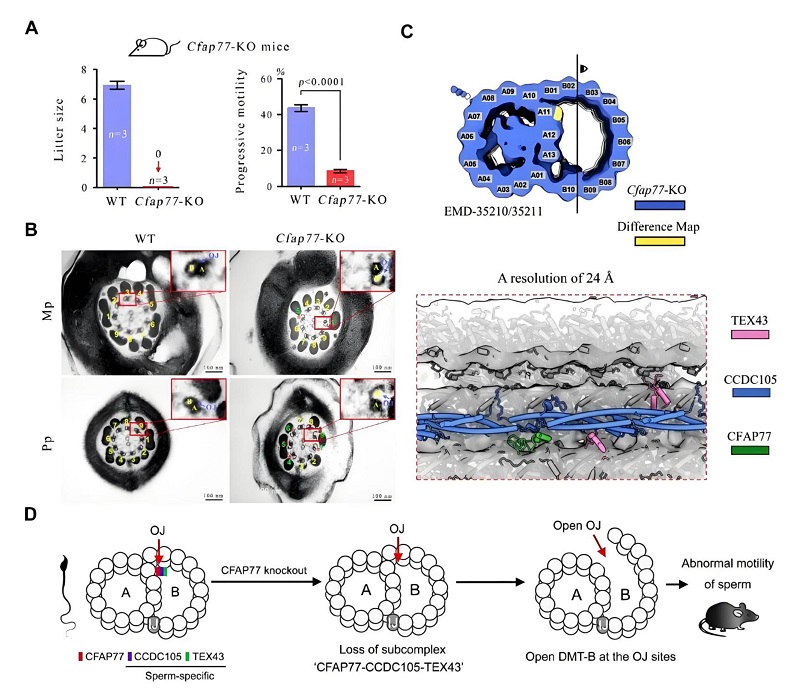
The core structure of cilia and flagella-the axoneme-is composed of microtubules and associated proteins arranged into a precise and stable architecture. The outer region of the axoneme consists of nine doublet microtubules (DMTs), each of which is formed by a complete A-tubule and an incomplete B-tubule.
A collaborative research team from the Institute of Biophysics of the Chinese Academy of Sciences and Beijing Normal University has identified the molecular components and regulatory mechanisms that link the A- and B-tubules within DMTs. They also revealed how axonemal DMTs are stably connected in cilia and flagella.
Their findings were published in PLOS Biology on October 21.
Using gene knockout mouse models and in situ structural biology techniques, the researchers identified that CFAP77 functions as a core outer junction (OJ) protein mediating the connection between A- and B-tubules in axonemal DMTs. They further uncovered the molecular cascade triggered by the loss of CFAP77-namely, the disruption of the CFAP77-CCDC105-TEX43 ternary complex, structural breakage of the A-B connection at the OJ site, and consequent impairment of ciliary and flagellar motility.
Male mice lacking Cfap77 (Cfap77) exhibit infertility with normal sperm count and morphology but markedly reduced sperm motility. Transmission electron microscopy revealed that approximately 45% of the DMT B-tubules in Cfap77-KO sperm axonemes were open at the OJ regions. This precise correspondence between protein loss and structural phenotype confirmed the critical role of CFAP77 in maintaining the OJ linkage between A- and B-tubules.
Cryo-electron tomography (cryo-ET) combined with AI-assisted analysis enabled the researchers to resolve the in situ axonemal structure of Cfap77-KO sperm in unprecedented detail. The results showed that deletion of CFAP77 led to the complete loss of the CFAP77-CCDC105-TEX43 ternary complex at the OJ regions, resulting in open B-tubules and defective sperm motility.
This study demonstrates the feasibility and power of integrating gene-edited animal models with in situ structural biology, providing a new paradigm for dissecting the molecular architecture and physiological function of the axoneme. This combined approach highlights a promising frontier for future research into the structural basis of ciliary and flagellar function.

Schematic illustration of the axonemal structure of cilia/flagella and the A-B tubule connection within DMTs. (Image by SUN Fei's group)

CFAP77 knockout leads to the loss of the CFAP77-CCDC105-TEX43 ternary complex and the opening of DMT B-tubules. (Image by SUN Fei's group)

86-10-68597521 (day)
86-10-68597289 (night)

52 Sanlihe Rd., Xicheng District,
Beijing, China (100864)

